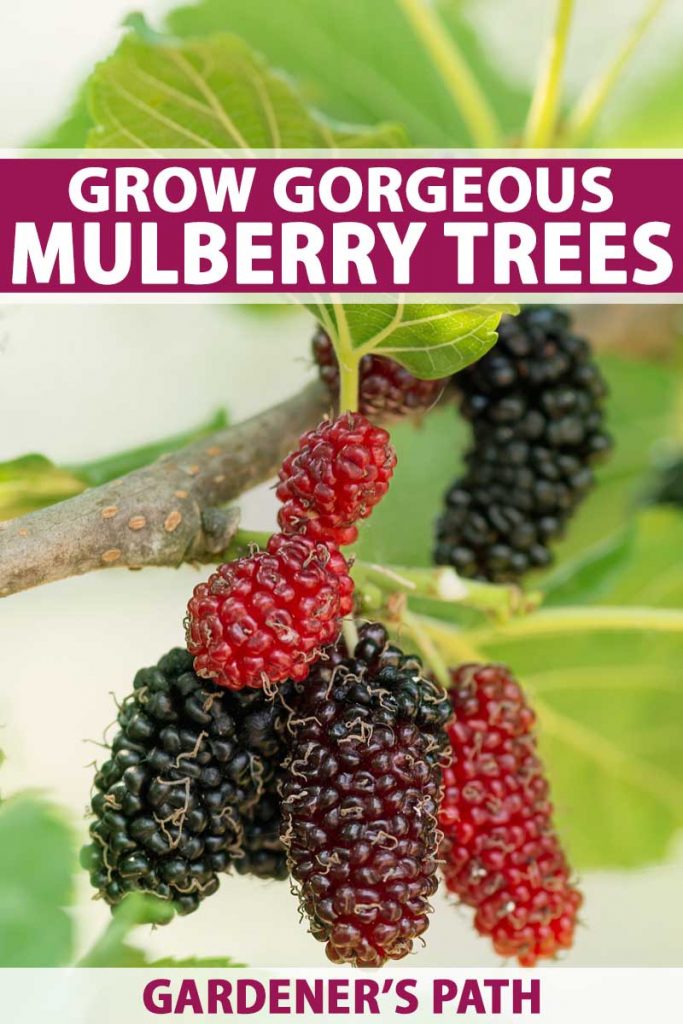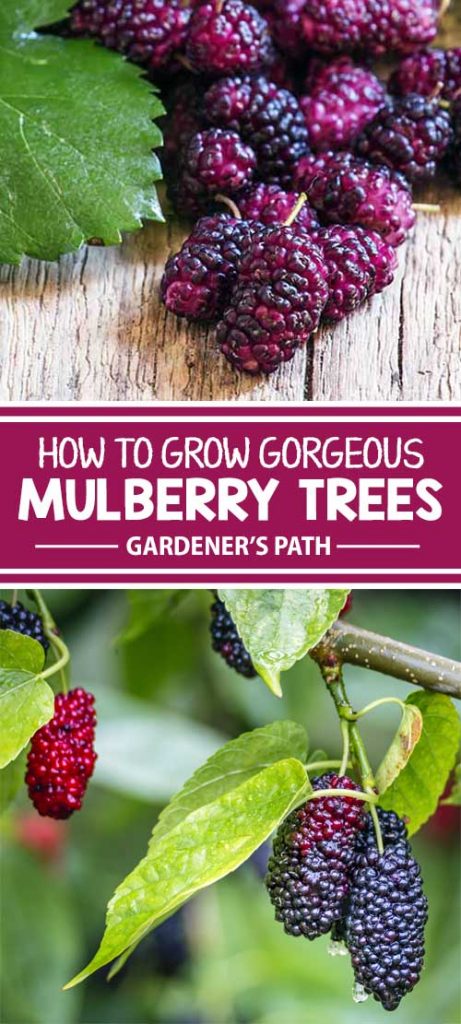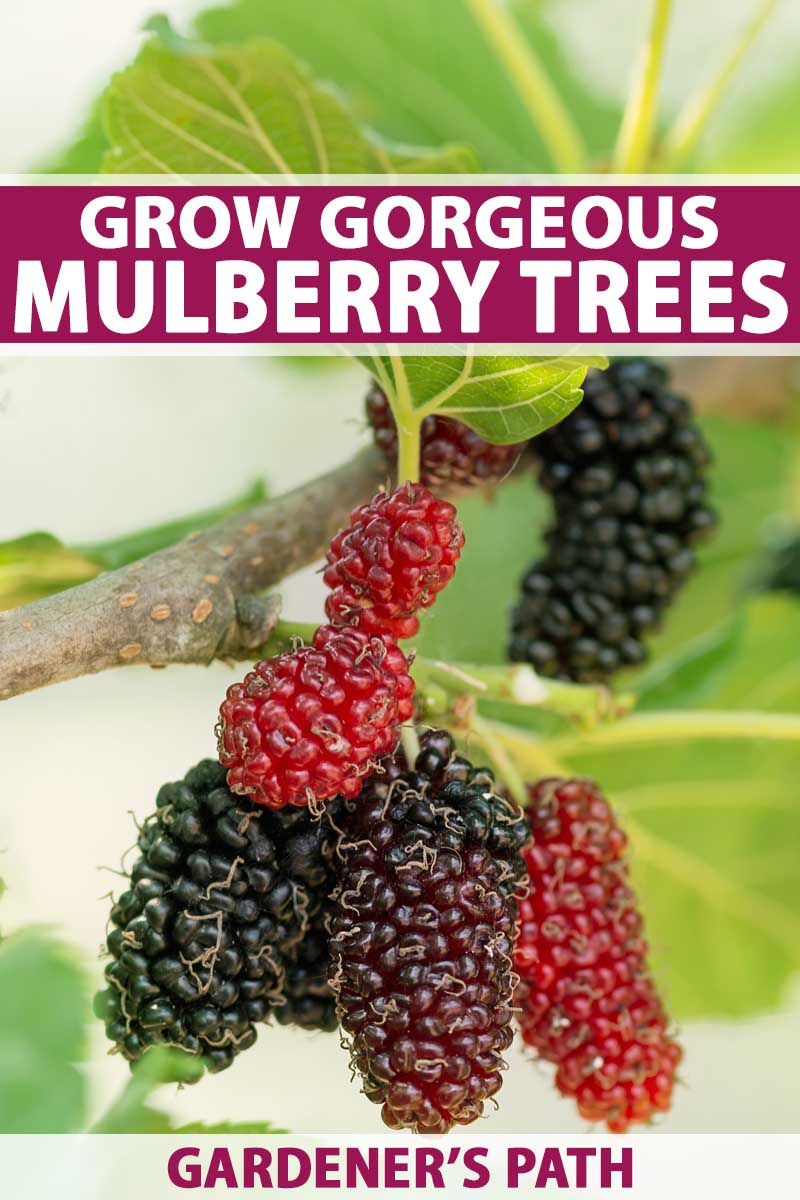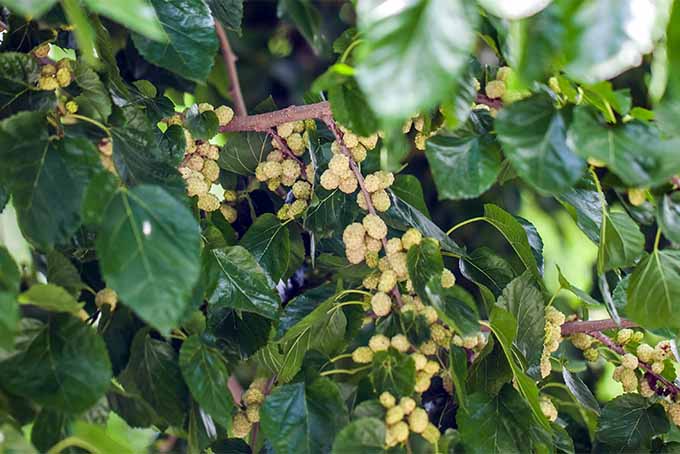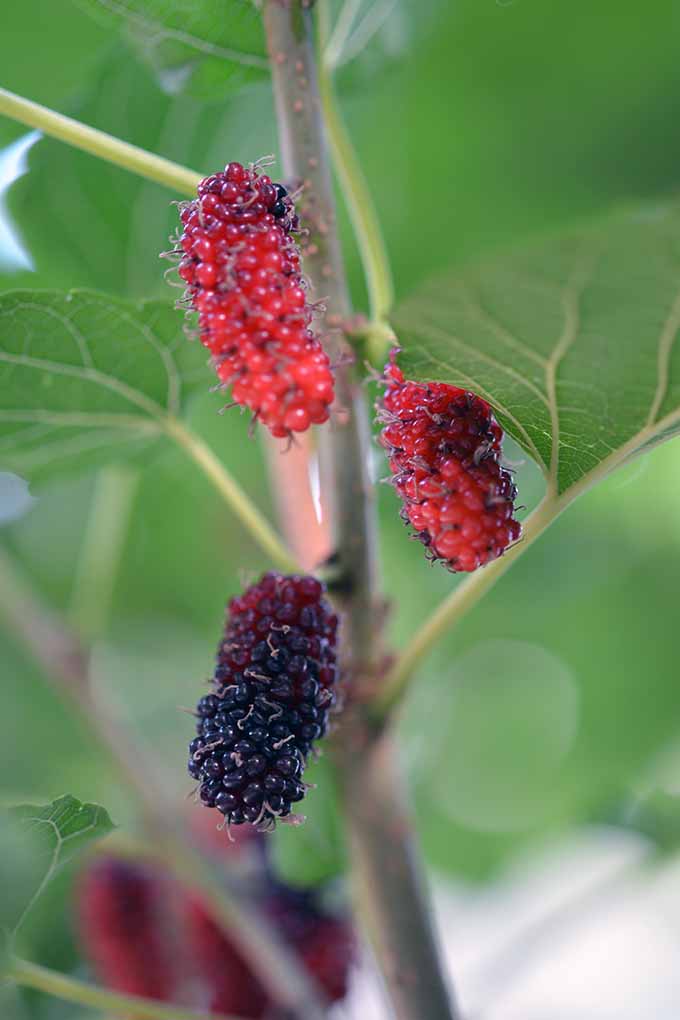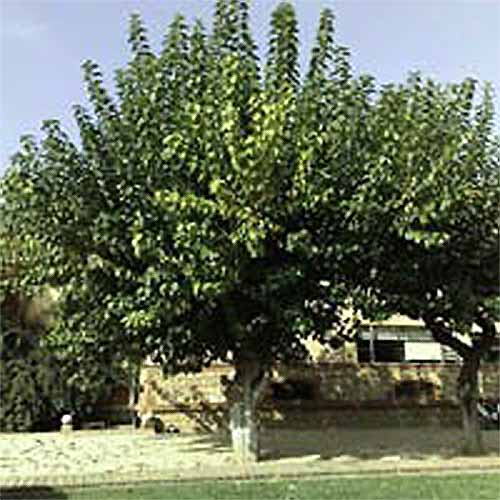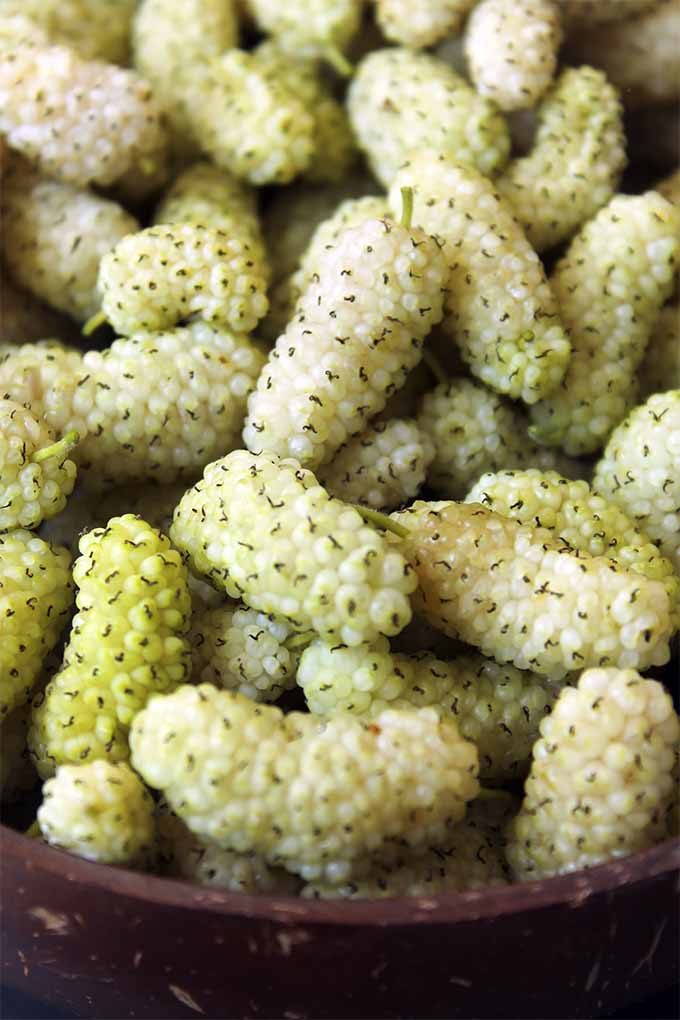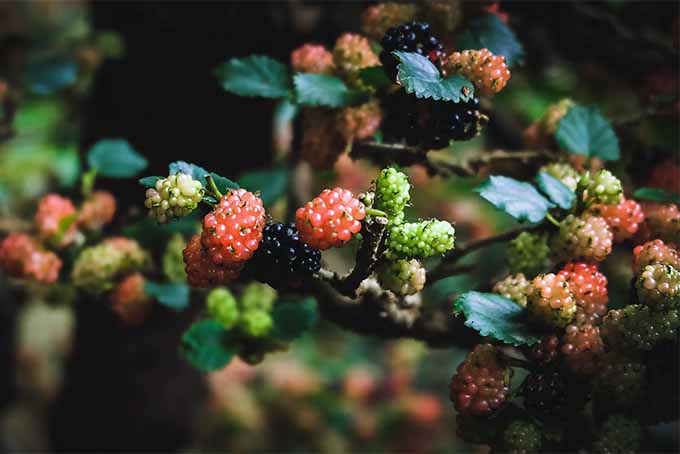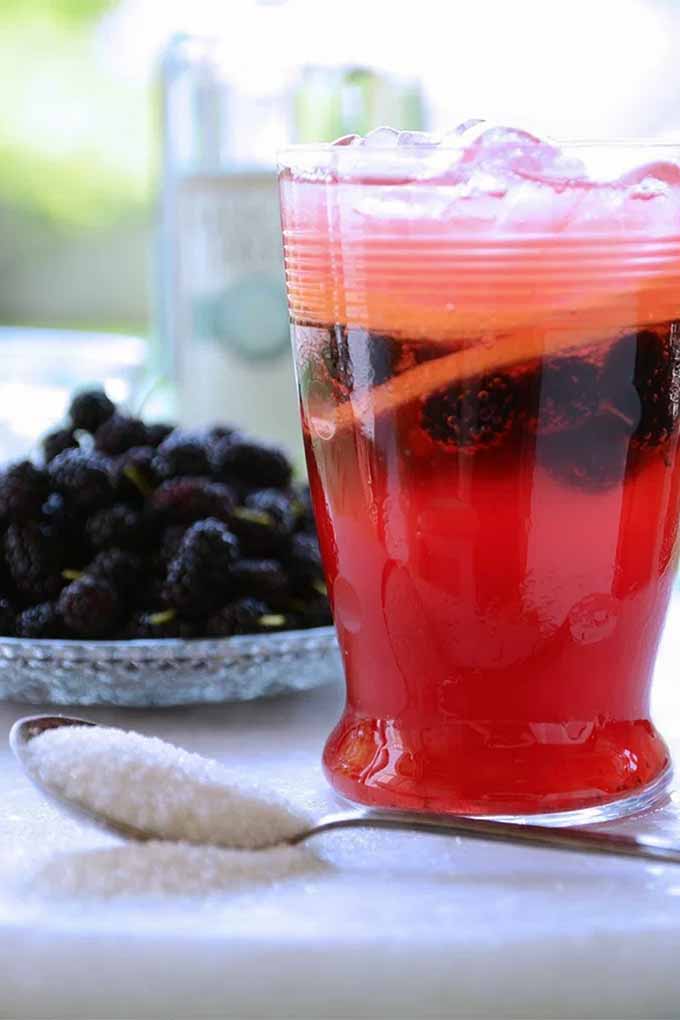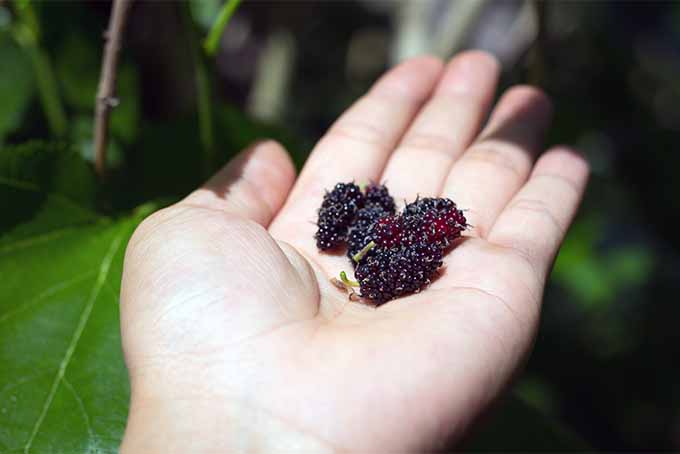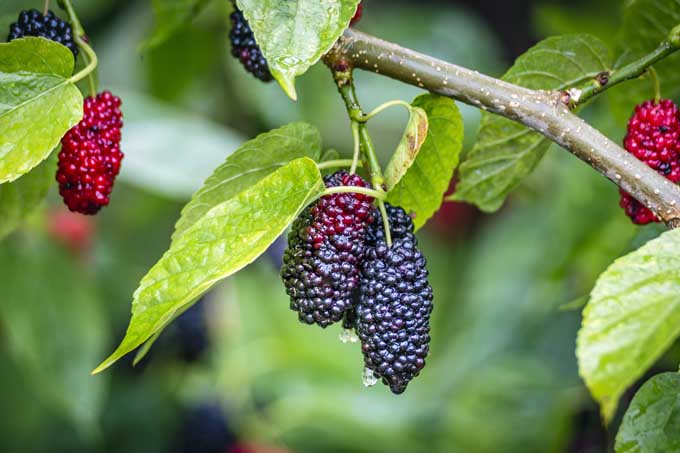We link to vendors to help you find relevant products. If you buy from one of our links, we may earn a commission.
Four Species, Three Homelands
Part of the moraceae family which also includes figs, four types of mulberry trees are dominant in the United States. The red mulberry (Morus rubra) is native to North America, and its deep red, almost black fruit was a favorite of indigenous populations, who ate the fruit dried, in sauces, and in dumplings. According to the University of Florida’s Institute of Food and Agricultural Sciences Gardening Solutions, the Timucua people used the tree’s fruit, leaves, and twigs to make dyes, and Seminoles made hunting bows from the tree’s branches. Many native peoples also used the plant medicinally. We’ll get to more of that in a bit.
The white mulberry (M. alba) is native to China, where for thousands of years it was cultivated as the food of choice for silkworms. As the art of silk-making spread to Japan, India, and Europe, travelers from the latter continent brought the tree to North America in hopes of spawning a silk industry here. While that industry never quite took hold here, the white mulberry did, spreading rapidly throughout the eastern United States and beyond. The white variety gets its name from the color of its flowers. Its fruit can be pink, purple, black, or white.
Paper mulberry (Broussonetia papyrifera) is another Asian import that is considered invasive in much of the United States because of its prolific ability to spread. Its name comes from its use as a material to make paper and cloth. The black mulberry (M. nigra) made its way to our shores from its native Iran. Its fruit is almost always black.
Beware of Polka-Dotted Sheets
Choosing a Proper Location
What if you don’t already have one (or more) of these fine trees in your yard? The fruits are popular with the birds, and you’re sure to see evidence of this – you’ll know they’ve been feasting when the droppings on your car windshield turn from white to a dark purple in early summer. Park carefully! On that note, you’ll want to guard the clothesline during these weeks, as well. Many a good white bedsheet has been ruined by a bird that gorged on berries earlier in the day.
Since the berries themselves are too messy for some, often getting tracked into the home where they can permanently stain carpets, fruitless versions of these fast-growing trees have become popular in recent years. The white fruitless variety, available from Nature Hills, is popular with homeowners who want the shade the tree provides, without the fuss! If you’re lucky enough to have mulberries on your property, I think you’ll find a number of ways to use them. Fruitless White Mulberry Read on for our best tips to bring this beautiful tree to your yard, and to raise it well! If you’re located in USDA Hardiness Zones 5-9, you’re in luck! It’s possible to grow this species yourself with relative ease. Mulberries shoot up quickly, making them a wise choice for locations where you hope to establish a wooded area in five years or less. They also reseed without much effort; you’ll have more than a few trees without even trying if the conditions are right.
For this reason, you’ll want to be certain that the area you choose to plant them is far away from underground utility lines or septic tile. The roots grow fast and relatively unobtrusively, but they will wreak havoc on these systems. The red and black varieties can grow up to 35 feet tall (or more, depending on the cultivar), and may live to be 100 years old, while the white can reach over 70 feet! Papers can get to be about 30 feet tall. Do your best to select a spot where the tree will be able to thrive undisturbed while it grows to its full potential. Mulberries do best in areas that get adequate moisture and drain well.
The black mulberry is especially fond of alkaline soils, and they favor locations alongside river beds. For this reason, it makes sense to amend your soil with a bit of sand, loam, or clay to provide it with the conditions it’s accustomed to. As for light conditions, it thrives in partial to full sun. We always try to grow ours in a full sun area, but keep in mind that when they grow taller, they will partially block out the light from one another. As long as most of the tree gets full sun at some point in the day, it will grow without issue. If you are planting a sapling, you’ll want to wait until the frost season is completely over. Use the instructions on your plant’s packaging to determine the appropriate depth to plant the tree.
It’s Like Magic!
It is also possible to plant cuttings from established trees. The USDA’s growing guide recommends that you remove 8- to 12-inch-long branches from a healthy tree at its normal pruning time. Make sure there are at least 3 buds on each branch.
Bury the cuttings right away by covering them completely in soil at a depth of 3 to 4 inches, preferably in June or July. Water daily, or as needed to keep them moist, for at least a month. The buds will then form shoots, which can be taken out and planted as small trees.
Some Trimming, Some Birth Control
The mulberry tree is one of the easiest to care for, and it only needs very minimal trimming in the dormant months. Only remove the most damaged or sickly branches, and never cut trees during sap production. How can you figure out when this is? If you see the tree “weeping” with liquid coming out at any location, wait to prune until this stops completely. Once mature, the mulberry can easily transition from delight to nuisance if it’s not kept in check. They have attained the status of “weed” in many areas, as they do spread without effort and can grow in between sidewalk squares or along the foundation of houses. If nuisance saplings are not pulled while small, their root systems will damage anything in their path.
Berry Harvest and Serving Suggestions
The beautiful thing about the mulberry fruits is that they are easy to pick – too easy, in fact. While you’re just barely touching the fruit or a nearby branch, the ripe fruits will just drop to the ground.
For this reason, the best method of harvesting involves placing an old sheet or blanket (one you won’t mind getting purple with stains) around the base of the tree, and gently shaking the branches above. You’ll have buckets of fruits from just one tree with little effort this way. Mulberries do not keep well, so plan to eat, preserve, or cook with them right away. It is pretty much impossible to remove the stems and seeds, and the berries are consumed whole. A perfectly ripe fruit can be enjoyed raw — just give it a gentle rinse first. What can you do with these culinary delights? Mulberries can make a tasty addition to any recipe requiring berries. Remember that mulberries can be very juicy and may cause your creations to be a bit watery. Unlike other berries, however, they do not hold up well to drying.
Mulberry Tart with Cardamom and Black Pepper
With the distinct taste of cardamom added, this tart tastes like an old-fashioned summer day! Topped with a scoop of vanilla ice cream, it’s truly divine. Get the recipe from Vintage Kitty. Fresh mulberries also make a nice substitute for raisins in many recipes. Toss them into a salad, add them to pancakes or muffins, and give them a starring role in your next smoothie or shake. I also love to serve them frozen in cocktails or lemonade.
Mulberry Lemon Gin Fizz
This refreshing summer beverage is a modern take on the sloe gin fizz, a classic cocktail that, sadly, isn’t made much anymore. The recipe for this sweet sparkler is available from Vintage Kitty. You can also make your own mulberry wine. While this is a rather involved process, the results are truly tasty! Nothing quite compares to homemade wine made with the fruits of your trees, and you really must try it at least once.
Numerous Healing Properties
As we mentioned above, resourceful indigenous peoples made good use of the red mulberry. They also used the plant to treat numerous medical ailments. The sap was used to treat ringworm. Tea made from the leaves was used for dysentery, weakness, and difficulty urinating.
Today, many continue to use the trees medicinally. The entire plant — leaves, stems, and fruit — contains antioxidants, which work against cell-damaging substances in your body. Korean researchers SB Kim, BY Chang, et al found that mulberries contain alkaloids that activate white blood cells and stimulate the immune system. Natural medicine adherents have ingested white mulberry leaves to help cure a sore throat. Others have used mulberry leaves to support balanced blood sugar levels. And practitioners of traditional Chinese medicine use mulberry as a remedy for redness and swelling.
100 Years of Shade
The mulberry tree is one of my favorites, as it provides shelter and fruit for generations. Unlike other fruit trees, it starts producing within its first two years, and it grows quickly to create a wind block for your residence.
If you’ve cast aside the idea of adding it to your yard, won’t you reconsider? With the fruitless versions available now, there’s no need to fear purple footprints on your rug. The beautiful foliage and flowers are reason enough to welcome it into your landscape design, and its low-maintenance attributes mean you can keep caring for it long after your desire to work hard has waned. Do you have mulberries? What are your favorite ways to enjoy the fruits? Please share in the comments section! And don’t forget to check out our article on how to grow elderberries, for something a little different that we think will be right up your alley. The staff at Gardener’s Path are not medical professionals and this article should not be construed as medical advice intended to assess, diagnose, prescribe, or promise cure. Gardener’s Path and Ask the Experts, LLC assume no liability for the use or misuse of the material presented above. Always consult with a medical professional before changing your diet or using plant-based remedies or supplements for health and wellness. With additional writing and editing by Gretchen Heber. Photo credit: Shutterstock, unless otherwise noted.
